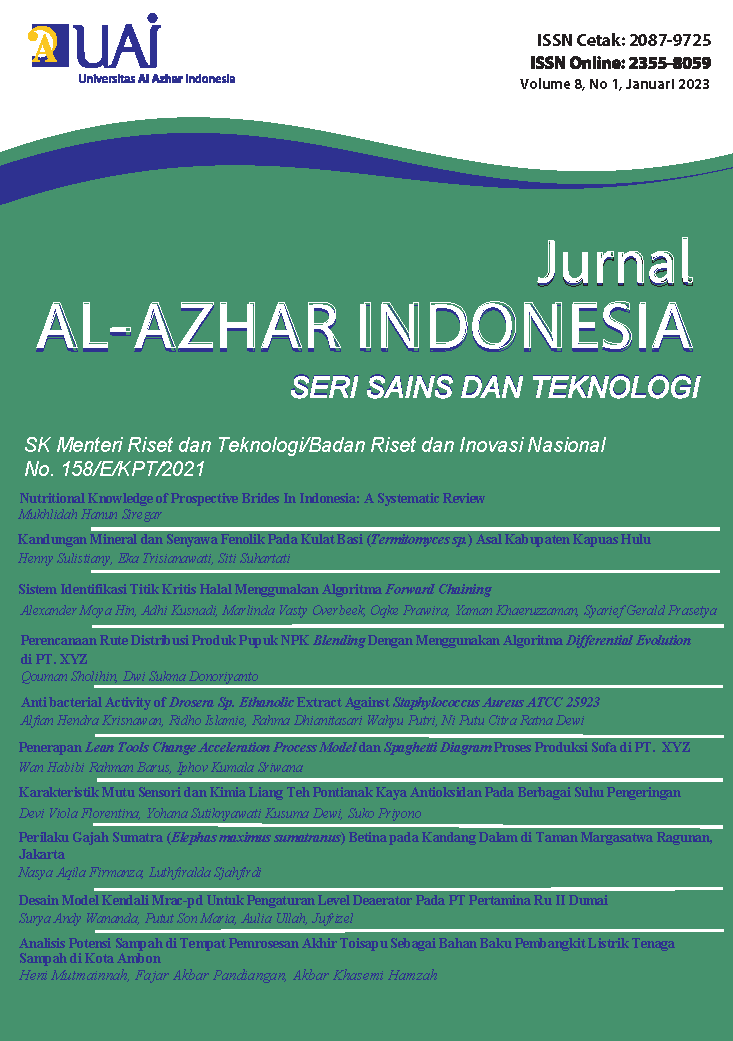Kandungan Mineral dan Senyawa Fenolik pada Kulat Basi (Termitomyces sp.) Asal Kabupaten Kapuas Hulu
DOI:
https://doi.org/10.36722/sst.v8i1.1352Abstract
Kulat basi (Termitomyces sp.) adalah jamur yang banyak ditemukan di Kabupaten Kapuas Hulu. Jamur ini memiliki kandungan mineral yang tinggi dan kemampuan sebagai antioksidan yang baik. Penelitian ini bertujuan untuk mengetahui kandungan 11 mineral (Cr, Fe, Cu, Mn, Zn, Ni, Mg, Ca, K, Na, Co) dan jenis senyawa fenolik pada tubuh buah kulat basi (Termitomyces sp.). Tubuh buah jamur dikeringkan menggunakan oven kemudian diekstraksi dengan metode maserasi menggunakan pelarut metanol. Analisis kandungan mineral dilakukan dengan Atomic Absorption Spectrophotometer (AAS) sedangkan analisis senyawa fenolik dengan Gas Chromatography-Mass Spectrometry (GC-MS). Hasil penelitian didapatkan bahwa urutan kandungan mineral tubuh buah kulat basi dari yang terbesar hingga terkecil adalah K>Mg>Fe>Cr>Na>Mn>Zn>Cu>Ca>Ni>Co. Mineral yang paling banyak terdapat dalam tubuh buahnya adalah kalium (18,74 ± 7,65 mg/kg) sedangkan paling sedikit adalah kobalt (0,003 ± 0,001 mg/kg). Senyawa fenolik pada ekstrak metanol tubuh buah kulat basi terdiri atas 5 senyawa dengan total kelimpahan sebesar 35,86%. Senyawa terbanyak adalah ethanol, 2-(9,12-octadecadienyloxy).
Keywords - Termitomyces sp., kulat basi, mineral, phenolic compound
References
R. Benchawattananon, “Biodiversity of mushrooms in conservative forest in Dansai District of Loei Province, Thailandâ€. Trop. Life Sci. Res, vol. 27, pp. 103-109, 2016.
S. Perotto, P. Angelini, V. Bianciotto, P. Bonfante, M. Girlanda, T. Kull, M.A. Selosse, “Interaction of fungi with other organismsâ€, Plant Biosystem, vol. 147, no. 1, pp. 208-218, 2013.
A. Winara, “Keragaman jenis jamur di hutan arboretum Balai Penelitian & Pengembangan Teknologi Agroforestry Ciamisâ€, Sains dan Teknologi, vol. 6, no. 1, pp. 41-48, 2016.
D. Suryanto, N. Irawati, E. Munir, “Isolation and characterization of cytinolotic bacteria and their potential to inhibit plant pathogenic fungiâ€, Micobiology, vol. 5, no. 3, pp. 144-148, 2011.
S.D.B. Tampubolon, B. Utomo, Yunasih, “Keanekaragaman jamur makroskopis di Hutan Pendidikan Universitas Sumatera Utara Desa Tongkoh Kabupaten Karo Sumatera Utaraâ€, Peronema Forestry Science Journal, vol. 2, no. 1, pp. 176-182, 2013.
P. Anggelini, G. Bistocchi, A. Arcangeli, E. Bricchi, R. Venanzoni, “Diversity and ecological distribution of macrofungi in a site of community importance of Umbria (Central Italy)â€, The Open Ecology Journal, vol. 8, pp. 1-8, 2015.
T. Gao, A. Nielsen, M. Hedblom, “Reviewing the strength of evidence of biodiversity indicators for forest ecosystems in Europeâ€, Ecological Indicators, vol. 57, pp. 420-434, 2015.
I.C. Nnorom, S.O. Eze, P.O. Ukaogo,â€Mineral contents of three wild-grown edible mushrooms collected from forest of south eastern Nigeria: An evaluation of bioaccumulation potentials and dietary intake riskâ€, Scientific African vol 8, no. 2, pp. 1-10, 2020.
N. Sengkhamparn, N. Phonkerd, 2014. Effects of heat treatment on free radical scavenging capacities and phenolic compounds in Tylopilus alboater wild edible mushroomsâ€, Chiang Mai J. Sci. vol. 41, pp. 1241-1249, 2014.
H. Thatoi, S.K. Singdevsachan, 2014. Diversity, nutritional composition and medicinal potential of Indian mushrooms: a reviewâ€, Afr. J. Biotechnol, vol. 13, pp. 523-545, 2014.
A. Srikram, S. Supapvanich, “Proximate compositions and bioactive compound of edible wild and cultivated mushrooms from Northeast Thailandâ€, Agriculture and Natural Resources, vol. 50, no. 6, pp. 432-436, 2016.
P. Manzi, L. Aguzzi, L. Pizzoferranto, “Nutritional value of mushrooms widely consumed in Italyâ€, Food Chem, vol. 73, pp. 321-325, 2001.
H. Rathore, S. Prasad, S. Sharma, “Mushroom nutraceuticals for improved nutrition and better human health: a reviewâ€. Pharma Nutrition, vol. 5, no. 2, pp. 35-46, 2017.
L.J.J. Van de Peppel, D.K. Aanen, “High diversity and low host-specificity of Termitomyces symbionts cultivated by Microtermes spp. indicate frequent symbiont exchangeâ€, Fungal Ecology, vol. 45, pp. 1-7, 2020.
J.L. Mau, H.C. Lin, C.C. Chen, “Antioxidant properties of several medicinal mushroomsâ€, J. Agric. Food Chem, vol. 50, no. 21, pp. 6072-6077, 2002.
D. Michelot, E. Siobud, J.C. Dore, C. Viel, F. Poirier, “Update of metal content profiles in mushrooms toxicological implications and tentative approach to the mechanisms of bioaccumulationâ€, Toxicon, vol. 36, pp. 197-2012, 1998.
M. Rasalanavho, R. Moodley, S.B. Jonnalagadda, “Elemental distribution including toxic elements in edible and inedible wild growing mushrooms from South Africaâ€, Environmental Science and Pollution Research, vol. 26, no. 8, pp. 1-13, 2019.
A.A. McDonough, L.C. Veiras, C.A. Guevara, D.L. Ralph, “Cardiovascular benefits associated with higher dietary K+ vs. lower dietary Na+: Evidence from population and mechanistic studiesâ€,. American Journal of Physiology-Endocrinology and Metabolism, vol. 312, no. 4, pp. E348–E356, 2017.

